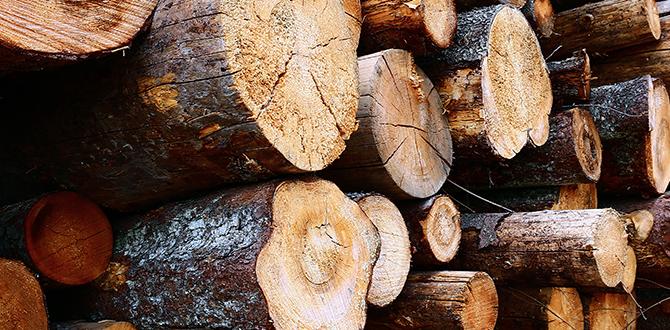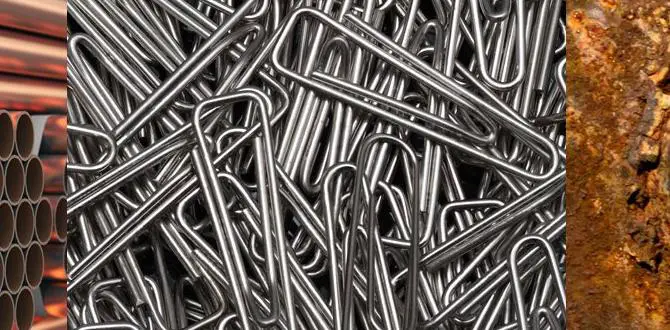Quick Summary: A 1/8 inch carbide end mill is an excellent choice for cutting plywood because its small diameter allows for detailed work and clean edges. Opt for a stub length with a higher flute count (more flutes) for smoother plywood cuts and better chip evacuation, especially when using MQL (Minimum Quantity Lubrication).
Hey everyone, Daniel Bates here from Lathe Hub! If you’ve ever tried cutting intricate shapes or small details in plywood on your CNC router, you might have run into some frustration. Plywood can be a tricky material – it can splinter, tear, and leave a fuzzy edge if you don’t have the right cutting tool. That’s where a specific type of bit comes into play: the 1/8 inch carbide end mill. It’s become an essential tool in my workshop for achieving clean, precise cuts in all sorts of projects, especially when working with plywood. In this guide, I’ll walk you through why this little bit is so great and how you can get those crisp edges you’re looking for.
Why the 1/8 Inch Carbide End Mill is Your Plywood Pal
When you’re working with plywood on a CNC machine, the type of cutting tool you use makes a world of difference. Plywood is made up of thin layers of wood veneer glued together. These layers can have different grain directions, and the glue itself can be tough on tooling. This is why a standard bit might leave you with chipped edges or a lot of sanding to do afterwards.
Enter the 1/8 inch carbide end mill. Why is this specific combination so effective? Let’s break it down:
- Size Matters (for Detail): The 1/8 inch diameter is perfect for creating fine details, small circles, tight corners, and intricate patterns. It allows you to get into tight spaces that larger bits simply can’t reach. This is crucial for projects like decorative inlays, miniature models, or detailed signage.
- Carbide Strength: Carbide is a super-hard material, much harder than high-speed steel (HSS). This means it stays sharp longer, can withstand higher cutting speeds and temperatures, and is more resistant to wear. For tough materials like plywood, carbide’s durability is a game-changer, leading to cleaner cuts and a longer tool life.
- End Mill Design: End mills are versatile cutting tools designed for milling operations. They can cut sideways as well as downwards, making them ideal for profiling (cutting out shapes) and pocketing (removing material from an area).
Think of it like this: trying to draw a very fine line with a thick marker versus a fine-tip pen. The 1/8 inch end mill is your fine-tip pen for CNC projects, allowing for incredible precision. When paired with the toughness of carbide, it becomes a powerhouse for tackling plywood.
Understanding the “1/8 Inch Shank Stub Length” Specification
You’ll often see specifications like “CARBIDE END MILL 1/8 INCH 1/4 SHANK STUB LENGTH FOR PLYWOOD MQL FRIENDLY”. Let’s unpack what each part means and why it’s important, especially for plywood:
Diameter (1/8 Inch)
This is the most obvious part. The cutting diameter of the end mill is 1/8 inch (or roughly 3.175mm). As we discussed, this is great for detail work.
Shank Diameter (1/4 Inch)
The shank is the part of the end mill that goes into your collet or tool holder. A 1/4 inch shank is a very common size for hobbyist and smaller professional CNC machines. It’s robust enough to handle moderate cutting forces without deflecting too much, and it’s compatible with a wide range of tool holders.
Length: Stub vs. Standard vs. Extended
This refers to the overall length of the end mill and, more importantly, the length of the cutting flutes. For plywood, a “stub length” end mill is often preferred. Here’s why:
- Stub Length: These end mills have a shorter overall length and a shorter flute length compared to standard end mills. This rigidity is key. Shorter tools vibrate less, which means less chatter, cleaner cuts, and a reduced risk of breaking the tool. When cutting plywood, which can be prone to tear-out, that extra rigidity helps maintain consistent contact and reduces flex.
- Standard Length: These are the most common and offer a good balance of reach and rigidity.
- Extended Length: These have longer flutes and shanks, useful for deeper cuts or reaching into cavities, but they are less rigid and more prone to vibration.
For cutting plywood with a 1/8 inch diameter, you likely don’t need a lot of reach. Therefore, a stub length end mill offers the stability needed for precise, smooth plywood cutting.
Flute Count (Number of Cutting Edges)
This is super important for plywood. Flutes are the helical grooves that run along the cutting part of the end mill. They allow material to be cleared away from the cut. The number of flutes affects how the tool cuts and evacrates chips:
- 2 Flutes: Generally good for softer materials and plastics, and often preferred for woodworking and plywood. They leave more space for chips to escape, which is vital when cutting fibrous materials like plywood. This helps prevent clogging and burning.
- 3 Flutes: A good all-around choice, offering a good balance of material removal and surface finish. They can be used for many materials, including some woods and plastics.
- 4 Flutes: Typically used for harder materials like metals. They provide a better surface finish with less vibration but can struggle to evacuate chips effectively in softer materials, potentially leading to burning or clogging.
For plywood, starting with a 2-flute or a high-quality 3-flute specific for wood or plastics is usually the way to go. This ensures that chips are efficiently cleared, preventing the tool from overheating and damaging the plywood surface.
“MQL Friendly”
MQL stands for Minimum Quantity Lubrication. It’s a system that sprays a fine mist of lubricant or coolant onto the cutting tool and workpiece. This reduces friction and heat, leading to longer tool life and a better finish. While you can cut plywood dry, using MQL can be beneficial, especially if you’re doing a lot of cutting or using faster speeds:
- Reduces Heat: Plywood can generate heat. MQL helps dissipate it.
- Improves Chip Evacuation: The mist can help carry chips away from the cutting zone.
- Better Finish: Less friction often means a smoother cut surface.
- Tool Life: Reduced heat and friction mean your carbide end mill will last longer.
An “MQL friendly” end mill simply means it’s designed to work effectively with this type of lubrication system, usually featuring internal or external channels in the flutes to direct the mist. If you plan on using MQL, look for this designation.
Choosing the Right 1/8 Inch Carbide End Mill for Plywood: Key Features
When you’re shopping for a 1/8 inch carbide end mill specifically for plywood, keep these features in mind:
Material Coatings
Some carbide end mills come with coatings that enhance their performance. For plywood, coatings like:
- Uncoated: Often perfectly fine for woodworking and plastics.
- TiN (Titanium Nitride): A common, general-purpose coating that adds some hardness and lubricity, reducing friction.
- AlTiN (Aluminum Titanium Nitride): Better for higher temperatures, but might be overkill for typical plywood CNC work unless you’re pushing speeds very high.
For most plywood applications, an uncoated or TiN-coated end mill will serve you very well. The hardness of the carbide itself is usually the primary benefit.
Helix Angle
The helix angle is the angle of the flutes. A steeper angle (higher helix) is better for smoother finishes and quieter cutting, while a lower angle (straight or shallow helix) can be better for harder materials and chip evacuation in some cases. For plywood, a moderate to high helix angle often provides an excellent balance.
Compression vs. Straight-Cut Bits
When cutting plywood, you’ll encounter the issue of tear-out on both the top and bottom surfaces. This is where compression bits shine. A 1/8 inch compression bit is essentially a specialized end mill designed to tackle this:
- Up-cut Flutes: These flutes spiral upwards, pulling chips away from the workpiece and helping to clear the pocket. They’re good for plunge cuts and chip evacuation but can cause tear-out on the top edge.
- Down-cut Flutes: These flutes spiral downwards, pushing chips away from the tool and helping to hold the material down. They create a clean top edge but can pack chips into a pocket.
- Compression Flutes: These bits combine both up-cut and down-cut helical sections. The top portion has up-cut flutes, and the bottom portion has down-cut flutes. This allows the bit to cleanly cut the top edge while also holding the plywood down to prevent tear-out on the bottom. They are exceptionally good for cleanly cutting through plywood in a single pass with minimal edge fraying.
If you are serious about getting clean edges on plywood with minimal sanding, a 1/8 inch carbide compression end mill is the absolute best choice. You can learn more about different types of router bits and their applications from resources like Toolstoday.com, which offers detailed explanations.
Practical Applications and Best Practices
So, what can you actually do with a 1/8 inch carbide end mill in plywood, and how do you get the best results?
Typical Projects
- Cabinetry and Joinery: Cutting precise dadoes, rabbets, and mortises for strong, clean joints.
- Jewelry and Decorative Items: Creating intricate patterns, pendants, and small ornamental pieces.
- Sign Making: Cutting out letters or detailed graphics for signs.
- Model Making: Building detailed architectural models or miniatures.
- Intarsia and Marquetry: Cutting precisely shaped pieces to fit together like a puzzle.
- Dovetail Jigs: Machining perfect dovetail joints with a CNC.
Cutting Parameters for Plywood
Cutting parameters are how deep you cut, how fast the tool spins (Spindle Speed/RPM), and how fast the tool moves through the material (Feed Rate). Getting these right is crucial for a good finish and to avoid burning or breaking the tool. Exact settings depend on your specific CNC machine, the type of plywood, and the exact geometry of your end mill, but here are some general guidelines:
General Plywood Cutting Parameters for 1/8″ 2 or 3-Flute Carbide End Mill:
| Parameter | Recommendation | Notes |
|---|---|---|
| Spindle Speed (RPM) | 18,000 – 24,000 RPM | Higher speeds can improve finish but increase heat. Start in the middle and adjust. |
| Feed Rate (IPM) | 30 – 60 Inches Per Minute (IPM) | This is for a single pass. Adjust based on chip load. Plywood can be abrasive. |
| Depth of Cut (DOC), Per Tool Diameter | 0.25x to 0.5x Tool Diameter (e.g., 0.031″ to 0.062″ for a 1/8″ bit) | For best results and to prevent chip recutting, aim for a shallow DOC. |
| Plunge Rate (IPM) | 15 – 30 IPM | Slightly slower than feed rate to prevent shock when entering material. |
| Stepover (for pocketing) | 30% – 50% of Tool Diameter (e.g., 0.037″ to 0.062″) | For a good balance of speed and finish. |
Note: These are starting points. Always perform test cuts on scrap material and listen to your machine. If you hear chattering or see burning, adjust your feed rate or depth of cut. Lowering the feed rate (moving slower) or reducing the depth of cut often resolves cutting issues.
Chip Load
Chip load is a crucial concept in CNC machining. It refers to the thickness of the material removed by each cutting edge of the tool as it revolves. A good chip load ensures the tool is cutting efficiently, not rubbing or burning. It’s calculated as:
Chip Load = Feed Rate / (RPM Number of Flutes)
For a 1/8 inch (0.125 inch) diameter, 2-flute end mill:
A good target chip load for plywood might be between 0.002″ and 0.005″ per tooth.
Let’s say we aim for a chip load of 0.003″:
Feed Rate = Chip Load RPM Number of Flutes
Feed Rate = 0.003″ 20,000 RPM 2 Flutes = 120 IPM
This suggests that with careful setup and good material, you could achieve higher feed rates. However, we must also consider the Depth of Cut (DOC) and the overall rigidity of the setup. For plywood, it’s often better to err on the side of caution and use a slightly lower feed rate with a shallow DOC to ensure a clean finish and prevent surface tear-out. This is why the table above provides conservative starting points.
Cooling and Lubrication
As mentioned, MQL can be very helpful. If MQL isn’t an option, ensure your CNC router has adequate dust collection to remove chips. This prevents them from building up and causing friction and burning.
You can find more information on calculating optimal cutting parameters from resources like the National Association of Manufacturers (NAM) website, which often provides links to engineering and manufacturing best practices.
Workholding
Securely holding your plywood is paramount. Use clamps, double-sided tape, or a vacuum table to ensure the material doesn’t shift during cutting. Any movement can result in inaccurate cuts or tool breakage.
Safety First!
Machining, even with smaller tools, requires attention to safety. Always:
- Wear Safety Glasses: Essential to protect your eyes from flying debris.
- Use Hearing Protection: CNC routers can be noisy.
- Keep Hands Clear: Never touch the workpiece or the tool while the machine is running.
- Ensure Proper Dust Collection: Plywood dust can be harmful if inhaled.
- Know Your Machine: Understand its limits and quirks.
- Inspect Your Tools and Machine: Make sure everything is in good working order before starting a job.
A well-maintained machine and sharp, undamaged tools are your first line of defense against accidents.
Where to Buy Quality 1/8 Inch Carbide End Mills
You can find 1/8 inch carbide end mills from a variety of sources. For reliable quality, consider:
- Specialty CNC Tooling Suppliers: Companies that focus specifically on router bits and end mills often have a wider selection and higher quality options.
- Reputable Tool Manufacturers: Well-known brands in the machining and woodworking tool industry.
- Online Marketplaces: Be sure to read reviews and check seller ratings carefully if purchasing from general online retailers.
Look for end mills made from high-quality carbide and ensure they are specifically noted for use with wood or plastics if that’s your primary material.
Frequently Asked Questions About 1/8 Inch Carbide End Mills for Plywood
Q1: Can I use a 1/8 inch end mill for all types of plywood?
Yes, you can, but the results might vary. Baltic birch plywood, for example, tends to cut cleaner with less tear-out than some softer construction-grade plywoods. Always test your settings on a scrap piece first. The key is the quality of the bit and your CNC’s rigidity.
Q2: What is the difference between a 2-flute and a 3-flute end mill for plywood?
A 2-flute end mill generally offers better chip evacuation, which is crucial for softer materials like plywood to prevent burning and clogging. A 3-






